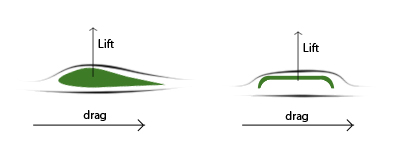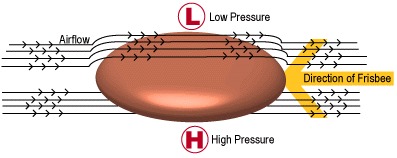The airfoil on a Frisbee uses the same principal as that of an airplane wing. The forces to be examined
in an airfoil are lift drag and gravity. Force due to gravity is mass*acceleration of gravity. For an airfoil to create
enough lift to fly or glide through the air, the force due to lift must be equal or almost equal to the gravitational
force. If you've noticed the force due to lift is not quite as large as the gravitational force because the Frisbee does
end up back on the ground. The lift force decreases over the flight of the Frisbee because of the drag produced by the
air friction.

http://ffden-2.phys.uaf.edu/211_fall2010.web.dir/Skyler_Evans/Airfoils_html_1335e8ae.jpg
The shape of the airfoil is the key to achieving lift. (Shape observed on above) The principle of an airfoil is that the
air flowing over the airfoil moves faster that the air moving under the airfoil. By the Bernoulli principle, the faster a fluid
moves, the less the magnitude of pressure. There is less pressure on the top of the wing than below the wing, so this
pressure difference causes lift. The angle at which the Frisbee is thrown also affects the flight of the Frisbee. This is
known as the 'angle of attack' and can determine how far the Frisbee ends up traveling.

http://people.math.sfu.ca/~jrg/visuals/frisbee_flow.gif